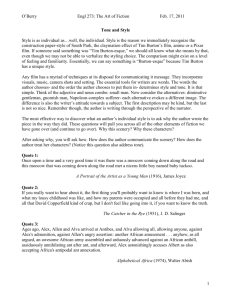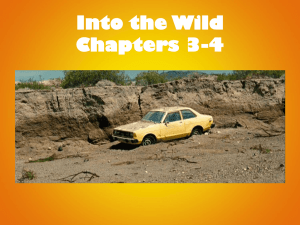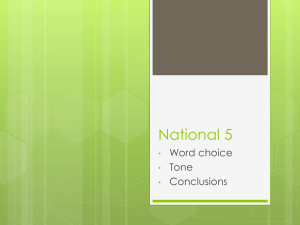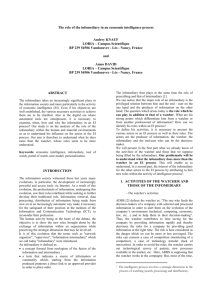The Lives of a Cell Notes of a Biology Watcher By: Lewis Thomas
advertisement
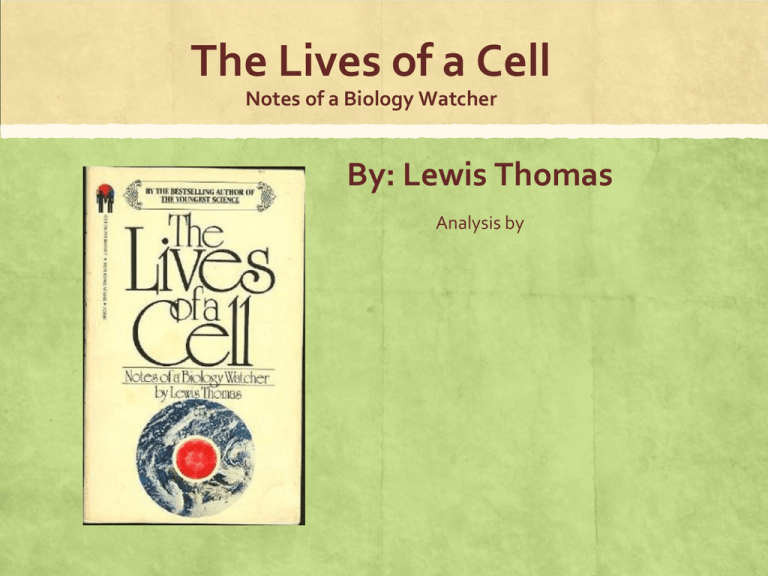
The Lives of a Cell Notes of a Biology Watcher By: Lewis Thomas Analysis by About Lewis Thomas (1913-1993) ▪ Physician, poet, etymologist, essayist, educator, and researcher. ▪ Born in Flushing, NY in 1913. ▪ Attended Princeton and Harvard Medical. ▪ Became Dean of Yale Medical and NYU School of Medicine. ▪ The Lives of a Cell won the National Book Awards in the Arts and Letters category, and The Sciences category. ▪ The Lewis Thomas Prize is awarded annually by the Rockefeller University to a scientist for artistic achievement. A Summary ▪ The Lives of a Cell: Notes of a Biology Watcher is a collection of 29 essays. ▪ It is based around the premise that the entirety of Earth can be best understood as a single cell. ▪ Thomas talks about the communication between organisms and the ways of a social organism. ▪ Also talked about is the relationship between man and the universe, our special place in it, and at the same time tells us that we’re not all that different and special. Major Thesis ▪ “I have been trying to think of the earth as a kind of organism, but it is a no go. I cannot think of it this way.… If not like an organism, what is it like, what is it most like? Then, satisfactorily for that moment, it came to me: it is most like a single cell.” ▪ “Who would consider for a moment that the more than 3 billion of us are a sort of stupendous animal when we become linked together?” (pg 103) ▪ One of the major points Lewis makes in The Lives of a Cell is the close relationship between organisms. He often uses etymology as a starting point, and in this quote he compares human characteristics to that of ants. Thomas’s style is to give a specific example as to how living things are connected, then broaden it to capture a larger scale. In the titular essay “The Lives of a Cell” he writes that he tried to think of the earth as an organism, but says that it is best understood as a single cell. For example, within cells there is a huge amount of communication and reliance on other components– organelles. Purpose ▪ “… we try to read human meanings in their arrangements…. Ants are so much like human beings to be an embarrassment.” (pg 12) ▪ “The social insects, especially ants, have been sources for all kinds of parables, giving lessons in industry, interdependence, altruism, humility, frugality, patience.” (pg. 64) ▪ The purpose of this book is to make readers draw a connection and really think about Earth and living things on many scales– large and small. Thomas tries to break it down by attempting to compare Earth to a single cell. ▪ A recurring theme is communication: oral, chemical, behavioral, and genetic. Thomas uses ants again and again to show the parallelism between humans and insects. He tries to show that humans are not “all that.” Tone ▪ “The usual way of looking at them is as enslaved creatures, captured to supply ATP for cells unable to respire on their own, or to provide carbohydrate and oxygen for cells unequipped for photosynthesis. This masterslave arrangement is the common view of full-grown biologists, eukaryotes all.” (pg 84) ▪ “The oldest, easiest-to-swallow idea was that earth was man’s personal property, a combination of garden, zoo, bank vault, and energy source placed at our disposal to be consumed…as we wished.” (pg. 122) ▪ The tone of these essays are very scholarly. Thomas uses very elevated language to professionally relay information. While erudite and scholarly, Thomas is obviously very passionate about science and his enthusiasm shows in the way he writes. The comparison of a master-slave arrangement is a much more involved and thought provoking than a piece where the author was detached and monotonous. ▪ In this second quote, Thomas might sound a little bitter and cynical about man. While he does try to downplay man’s prominence on Earth, he does not write with a tone of antagonism or patronization. Diction ▪ “If we can rid ourselves of some of our chronic, degenerative diseases, and cancer, strokes, and coronaries, we might go on and on. It sounds attractive and reasonable, but it is no certainty.” (pg. 56) ▪ “There are fascinating ideas all over the place, irresistible experiments beyond numbering, all sorts of new ways into a maze of problems… It is a puzzling time, but a very good time.” (pg. 139) ▪ The language used in The Lives of a Cell is a very learned jargon. Lewis Thomas is a man of science and medicine and uses many biological terms and elevated language. Many words are polysyllabic and uncommon. ▪ Thomas writes very elegantly and poetically. His enthusiasm translates into euphonious words and sentences. This creates a pleasant tone for the reader, because it sounds nicer and flows better. Figurative Language ▪ “Some animals simply nod at each other in passing, never reaching even a first name relationship.” (pg. 102) ▪ “They are, despite their efforts at dignity, rather like young animals engaged in savage play.” (pg. 118) ▪ Thomas uses figurative language like personification and similes to help readers make connections. In the first quote, he talks about animals being on a first name basis with each other as if they were humans. This gives readers and idea of what kind of communication and interaction goes on between organisms. In the second quote, Thomas uses a simile to compare scientists in their journey for information to savage animals. This again illustrates Thomas’s enthusiastic but scientific tone. Syntax ▪ What are we going to do if it turns out that we have pheromones? What on earth would we be doing with such things? With the richness of speech, and all our new devices for communication, why would we want to release odors into the air to convey information about anything? ▪ “Are we to be stuck forever with this problem? Where on earth does it go? Is it simply stopped dead in its tracks, lost in humus, wasted?” (pg. 60) ▪ Because the tone of these essays are erudite and scholarly, the sentences are generally very long and involved. The sentences are compound and complex to relay as much information as possible. Thomas also asks a lot of rhetorical questions not really looking for an answer. They are supposed to be thought provoking and make readers think deeply. Imagery ▪ “…a single molecule of which will tremble the hairs of any male within miles and send him driving upwind in a confusion of ardor.” (Pg 18) ▪ Imagery is used occasionally to paint a picture about the actions of animals. In this quote, a moth is described using the sense of feel. There’s the physical feeling of ‘trembling,’ and the mental feeling of ‘confusion.’


